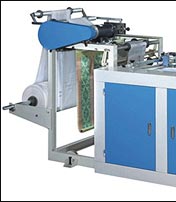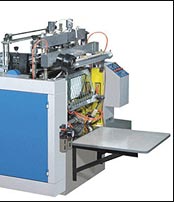Handling Equipment
Pack sealing or closing equipment is usually part of or situated
immediately adjacent to the pack filling machine, for use before and after
the filling operation. A number of different methods are available to close
the pack, although each different type of pack has a limited number of
options that are applicable.
Adhesive Sealing
Cold or hot melt adhesive applicator applies a shot or spray of adhesive on
to the inside surface of the flaps of a carton or case prior to folding of
the flaps.
Heat Sealing
Electrical cartridge elements provide heat to a contact surface to melt two
polymeric packaging materials together under pressure. This technique is
used in sandwich packs, ready meals and in modified atmosphere packaging.
Opposite surface of pack needs supporting to oppose the applied pressure.
Stapling
Staples are used to hold the flaps of a multi-ply cardboard case together.
The operation of pack stapling equipment works on the same principle of a
desktop paper stapler, where the staple is displaced from a magazine and an
anvil forms the opposite side of the staple.
Taping
Adhesive backed tape is applied to upper and lower closed flaps of a case.
It is operated as the case is passed over the top of a tape head to seal the
lower flaps or underneath of a tape head to seal the upper flaps. The tape
applicator can be built in to a case erecting machine or be a simple hand
held tape gun.
Can Seaming
The vertical edges of a rolled can body are formed around each other to
lock together. The upper and lower edges of a can body and the can lid are
formed around each other to provide a tight seal between the body and the
lid. The body and lid seaming operation is carried out before and after the
filling operation.
Capping Machines
Capping machines provide a closure and seal for bottles. The commonly used
types of cap are screw, cork, plug and crown. The position of the bottle
needs to be controlled, as it does for filling. A cap is picked up and
located on the top of the bottle. For some applications a number of
different caps are fitted to the bottle during successive capping
operations. Pack Handling Equipment The efficient operation of packaging
machines is reliant upon begin able to supply the product and packaging
materials at the correct rate, to be able to move them quickly between
processes. Additional operations sometimes require that the pack orientation
needs to be changed between processes.
Pick and Place
Pick and place robots are used to manipulate closed packs. The robotic arms
are used to transfer the completed pack from the outfeed of the last
packaging operation to the case packing station. Here the pack is loaded
straight into the waiting transit case.
Palletisation
Packaging materials may be delivered to the packaging line on pallets, to
transfer the packs onto the production line depolarizers are used. Stable
packs can be pushed directly from the pallet onto the packaging machine
infeed conveyor, however more complex packs may require more sophisticated
means of transfer onto the packaging machine infeed conveyor belt. At the
end of the packaging operations, transit packs are often loaded onto
pallets, palletisers are used to transfer the transit packs onto the
pallets. This involves pushing the accumulated transit packs onto the pallet
a layer at a time or by lifting a layer of transit packs and placing in
position on top of the previous layer of packs.

 Unscrambling
Unscrambling
Small pack components such as bottle plugs and caps are normally supplied
in bags. To ensure that the components are presented to the machine
equipment in the correct orientation they will need to be unscrambled. The
bags of each pack component are poured into individual vibratory bowls.
These bowls have a ridge on the sidewall that spirals from the bottom of the
bowl to the top and the vibrations cause the components to travel up the
ridge. At the top of the ridge the components travel down a shoot and are
stopped at the pick up point.
Conveying
Conveyors provide an excellent means of transferring product and/or packs
between packaging processes, the commonly used types of conveyors are:
- Belts
- Bands
- Chain and Peg
- Indexing
- Roller
- Pallet
- Elevating
- Vertical
- Accumulating
These conveyor types provide different functions for a wide range of
product / pack types. Conveyor systems can be designed simply to transport
product/packs or to be capable of storing masses of product/packs to cope
with differing machine output rates.



